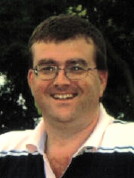August 8, 2010
Player Profile Index (Men) Tennis Server
|

 |
August 8, 2010 Editorial by Vince Barr.
W&SFG Women's Open Cincinnati 2010 Preview  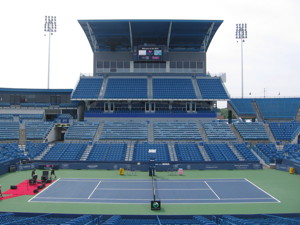 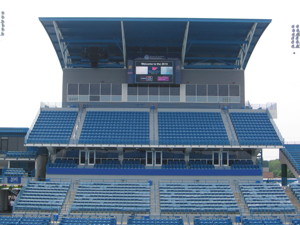 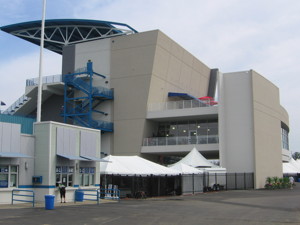 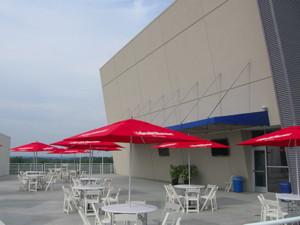  (Photos courtesy of Betsy Ross of Game Day Communications, and Eric Duncan of W&SFG Tournament Staff) The reason all of the capital improvements are being done is to prepare for next year's combined event for both men and women. It will become like a mini grand slam tournament where the guys and girls will alternate matches on all tournament courts. This is the only stop in the Midwestern U.S. where top-tier men and women's players will be playing prior to the start of the U.S. Open. Additionally, next year's combined event will be played in only eight days (main draw) with both qualifying tournaments being played simultaneously the previous 2-3 days. Still to come include the addition of six new player practice courts on the north side of the property in order to accommodate all the players needing practice time, which will not be insignificant given the fact that there are players who enter only the doubles draw. The finalized women's draw (with the identity of all wild cards and qualifiers) should be available at http://www.cincytennis.com. You should also be able to obtain the order of play for each day from that particular web site as well. Many of you might be interested in learning how tournaments determine their playing fields. Most of the time, this process happens behind closed doors between tournament officials and the respective governing bodies of the men's and women's tour. But this event began inviting series ticket buyers to observe the process along with members of the media many years ago, which has served to increase the interest in this event. Here, the draw party includes a catered buffet (which is nothing short of excellent) and this year, both Ana Ivanovic and Sabine Lisicki were on hand to offer player perspectives on their reaction the draw. I spoke with several individuals here who also provided further insight as to how the draw actually gets put together. The Western & Southern Financial Group Women's Open contains 56 players, 16 of whom are seeded according to the latest rankings (August 2nd). The top eight players receive first round byes which then provides a field of 64. The tournament also has four wild card spots that they can hand out at their discretion. Ordinarily, there would be eight spots available for the qualifiers but the tournament can choose to increase this number to 12 which is what they did this year. The last player directly accepted into the main draw was Sybil Bammer, ranked 48th. If you think about it, the goal of any tournament is oriented towards ensuring that the top players will only play each other towards the end of the event. It is also in the interest of any tournament to make sure that each playing field is as fair as it possibly can be. No tournament director wants all the top seeds clustered in either the top or bottom half of the draw; they would prefer them to be scattered evenly throughout. The same is true from the player's point of view. The stakes are extremely high at this level of competitive tennis in terms of money (the winner of the women's event takes home $350,000 while the runner-up pockets $175,000) as well as rankings points (the winner gets 900 points while the runner-up gets 620). For obvious reasons, the first and second seeds are placed on opposite sides of the draw such that they could only meet in the finals. The other 14 seeds (for a total of 16 seeded players) are scattered throughout the draw but the order of placement is not arbitrary. To help you visualize how the brackets are filled out, think of your typical "March Madness" NCAA basketball tournament bracket with 64 spots for players. The first position is for the # 1 seed while the 64th position is for the # 2 seed. After the top two seeds are placed, the other 14 seeded players are assigned poker chips, placed faced down on a table and then drawn randomly within their peer groups by a WTA Tour official. The peer groups are always standardized and never vary and are as follows: (1) for the 3rd and 4th seeds; (2) for the 5th through 8th seeds; (3) for the 9th through 12th seeds and (4) for the 13th through the 16th seeds. The exact placement in a given draw (i.e., on a specific line) for each peer group is also standardized. An example should help clarify this process. The first peer group is for the 3rd and 4th seeds. The WTA official randomly selects between these two chips, so there is an equal probability of this person drawing either the third or 4th seed. The first chip that is drawn will go to line # 17 while the second chip will go on line 48. So, the third seed could end up on either line but nowhere else and same is true for the fourth seed, depending on which one is chosen first (this is the randomized part of the process). The next draw is a selection of players seeded 5th through 8th. The first chip drawn goes on line 16, the second one drawn is placed on line 32, the third on line 33 and the fourth on line 49. Again, the randomized part of this process means that any of the seeds 5-8 could go on one of the four lines. The third peer group is drawn in like manner with spots going on lines 9, 25, 40 and 56. The last group is placed on lines 8, 24, 41 and 57. This is how both tours conduct their draws to ensure the highest probability that seeded players won't face each other until the Round of 16. The U.S. Open uses the same process but the line numbers are slightly different since it is a 128-player draw with no first round byes and a total of 32 players are seeded. The seeds are placed in the draw before any of the other players are slotted. In the Western & Southern tournament, the top 8 seeds receive first round byes, so these are then placed in the draw. Then the rest of the players are drawn starting on line 3 and proceeding in order until the 62nd line has the last player in (since line 64 has the # 2 seed and line 63 is their first-round bye). Seeds are determined using the most recent rankings which, in this case, are the players listed as of August 2nd. Before the draw started, several players had to withdraw. Serena Williams pulled out on July 16th due to a foot injury caused by some broken glass that required some minor surgery to correct. Venus Williams withdrew on August 6th because of a knee injury; Samantha Stosur cited fatigue in pulling out and Justine Henin had to withdraw after suffering her serious elbow injury at Wimbledon this year. Still, that left this tournament with seven of the top 10-ranked players in the world (and 17 of the top 20). Most tournaments (outside the slams) can only wish for this type of playing field. Nowhere else in the Midwestern U.S. will you be able to see this kind of event featuring this many of the top female players in the world. One statistical oddity occurred while the women's draw was underway that I thought was worth reporting. After all seeds were placed in the draw and the rest of the bracket was being filled out, a qualifier was selected on five consecutive chances, which virtually never happens. As it turned out, this will benefit the defending champion, Jelena Jankovic, as these five qualifiers all landed in her quarter of the draw. So, after a first round bye, she'll face a qualifier in the second round and has a very high probability of drawing another qualifier in the Round of 16. That would occur if the 14th seeded player (Aravane Renzal from France who is currently ranked 18th) loses either of her first two matches since both will be against a qualifier. There was some concern here that she might also have to withdraw due to injury. Her player blog on the internet (http://www.jj-jelenajankovic.com/eng/blog.php) explains her current situation. "Let me catch you up on what I've been up to. As you know I injured my back at Wimbledon. I couldn't train for 10 days, but also during that time I took a little vacation, so that was okay. I went to Venice with my family, which was a really enjoyable time," Jankovic said. "I started training again and went to Portoroz (in Slovenia), which is a beautiful place. My family (as well as) my boyfriend (accompanied me), which was great. I went on a yacht and went for walks next to the sea every day. The people there were really nice. It was my first time there, and everything was so well organized, hopefully I'll go there again next year," Jankovic continued. "Unfortunately, in my second round match, I was up 6-1, 2-0 and went running for a ball and twisted my ankle. I had to retire and I haven't hit since then. I'm still recovering. I came back to Serbia afterwards and have a whole team of doctors helping me get healthy as fast as possible. They have been with me for a long time so I know they are doing everything they can," she said. "Injuries aren't welcome but that's part of the sport. I've had some really bad luck in my last two tournaments but (I just have to) hope for the best and keep working hard. I am back at No.2 in the rankings now and I've been playing well, I just pray my health will be all right so I can continue to do my job the best I can." She did play at the Mercury Insurance Open in San Diego last week, but lost her second round match to Alisa Kleybnova, 5-7, 2-6 after getting a first round bye. The tournament will make every effort to give her the latest start possible (which is probably Wednesday) but if that ankle is not completely healthy, she could be in for an upset by her opponent despite the fact that she will face a qualifier. Caroline Wozniacki is the second seed here and she will get a late start since she won the E-boks Sony Ericsson Open in Copenhagen, Denmark last week. While elite pro players are used to the demands of near-constant travel, she has quite a commute ahead of her to get here next week. Copenhagen to Cincinnati is 4,300 miles and there are no direct flights between the two cities. That generally does not pose a problem for athletes at her level since she could easily charter her own flight. But conservatively estimated, that is about a nine to ten-hour flight if she goes non-stop and has to deal with a six-hour difference ahead of Cincinnati. I would look for her to have a Wednesday start as well since she, like Jankovic, has a first-round bye. The most difficult match of the first round has to be Maria Sharapova (ranked 13th) vs. Svetlana Kuznetsova (ranked 21st). Kuznetsova is in the finals of the championship match of the Mercury Insurance Open in San Diego (playing against Agnieszka Radwanska). You hate to lose either player, especially in the first round. But this kind of draw sometimes occurs in a tournament. While I don't have any advance notice of who will be playing whom, especially that far in advance, it would make the most sense to me to have that as the feature match on Wednesday night. Other players to watch include crowd favorite Melanie Oudin, who made an inspired run to the quarterfinals of the U.S. Open last year. She is currently ranked 45th in the world and plays Elena Vesnina of Russia. My sentimental favorite in this event would have to be Kim Clijsters who won the U.S. Open last year after having a daughter. She made her return to the WTA Tour here last year and got as far as the quarterfinals in a losing effort to eventual finalist Dinara Safina, 2-6, 5-7. She is the fourth seed and could very well play a rematch with Safina in the second round (Safina must first win her match with Roberta Vinci of Italy). That would be a great match to see since Clijsters noted in her post-match interview last year (in the loss to Safina) "I kind of feel like I want to go out there right now and do it all over again and try to figure out a few things out there. But obviously that's not possible," Clijsters noted. For those of you who are unable to make it to Cincinnati for this event, you can follow along on television as both the Tennis Channel and ESPN-2 will be providing coverage. The most updated television schedules may be found at http://www.usopenseries.com.
All Tennis Server photography is copyrighted by the photographer and/or the Tennis Server, and all rights are reserved. You may not copy these images without permission. While you are welcome to create hyperlinks to Tennis Server web pages, you may not embed these images into other web pages or blogs without permission. To request permission, please use this contact form. Please be sure to clearly indicate exactly which photograph(s) you are requesting permission to use, as terms and conditions will vary depending on the photographer and the photograph.
|



October 2022 Tennis Anyone: Patterns in Doubles by John Mills. September 2022 Tennis Anyone: Short Court by John Mills. |
 You will join 13,000 other subscribers in receiving news of updates to the Tennis Server along with monthly tennis tips from tennis pro Tom Veneziano.
You will join 13,000 other subscribers in receiving news of updates to the Tennis Server along with monthly tennis tips from tennis pro Tom Veneziano. 